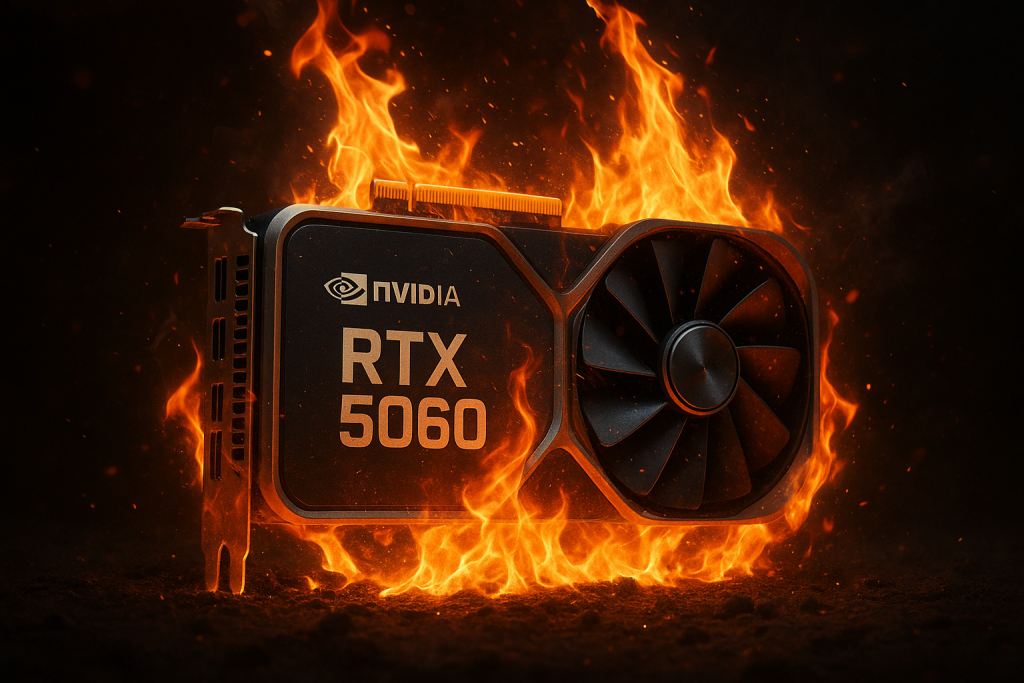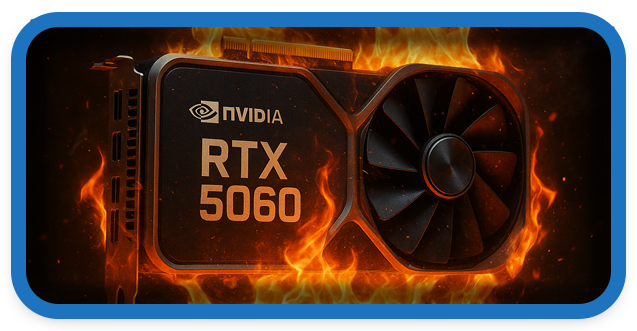⏲️ Estimated reading time: 6 min
How To Make Best Settings Nvidia Control Panel RTX 5060
Unlock the full potential of your NVIDIA GeForce RTX 5060 by configuring the best settings in the NVIDIA Control Panel. This step-by-step guide shows you how to maximize gaming performance, boost visual quality, and achieve smoother gameplay.
NVIDIA GeForce RTX 5060
The NVIDIA GeForce RTX 5060 is part of NVIDIA’s next-generation lineup, offering powerful performance for gamers, creators, and professionals. With cutting-edge architecture, AI-enhanced rendering, and improved ray tracing, this GPU is designed to handle the latest AAA games and demanding workloads.
However, out-of-the-box settings in the NVIDIA Control Panel don’t always deliver the best experience. By customizing specific options, you can squeeze more performance out of your RTX 5060, reduce stutter, minimize input lag, and enhance image quality.
In this guide, we’ll go step by step through the NVIDIA Control Panel settings for the RTX 5060, explaining what each option does and how you should configure it depending on your needs—whether you want maximum FPS, best visuals, or a balance of both.
Why Optimize the NVIDIA Control Panel?
Even if your PC is powerful, unoptimized settings can bottleneck performance. NVIDIA’s Control Panel gives you a direct way to influence how your GPU handles rendering, scaling, and display output. Some of the benefits of tweaking these settings include:
- Higher FPS in competitive games.
- Reduced input lag for faster reactions.
- Sharper visuals without sacrificing too much performance.
- Better power efficiency when gaming on laptops or small-form-factor PCs.
- Consistency across different games, so you don’t have to adjust settings manually every time.
Step 1: Update Your Drivers
Before adjusting anything, make sure your RTX 5060 drivers are up to date. NVIDIA regularly releases Game Ready Drivers that improve stability, optimize new titles, and fix bugs.
- Download and install GeForce Experience from NVIDIA’s official website.
- Open it and check for updates.
- Install the latest driver and reboot your PC.
Having the latest driver ensures that all Control Panel options work properly and performance is maximized.

Step 2: Access the NVIDIA Control Panel
- Right-click on your desktop.
- Select NVIDIA Control Panel from the context menu.
- If you don’t see it, reinstall your drivers and check again.
Step 3: Adjust Global 3D Settings
This is where most of the optimization happens. Go to Manage 3D Settings > Global Settings.
Recommended RTX 5060 Settings:
- Image Scaling: On (for better performance at lower resolutions).
- Ambient Occlusion: Performance (or off if you need maximum FPS).
- Anisotropic Filtering: Application-controlled.
- Antialiasing – FXAA: Off (causes blurriness).
- Antialiasing – Mode: Application-controlled.
- Background Application Max Frame Rate: 20 FPS (saves power).
- CUDA – GPUs: All.
- DSR – Factors: Off unless you want downsampling for better visuals.
- Low Latency Mode: On (or Ultra for competitive shooters).
- Max Frame Rate: Off (unless you want to cap FPS).
- Monitor Technology: G-SYNC Compatible (if your monitor supports it).
- Multi-Frame Sampled AA (MFAA): Off.
- OpenGL Rendering GPU: Select your RTX 5060.
- Power Management Mode: Prefer Maximum Performance.
- Preferred Refresh Rate: Highest available.
- Shader Cache Size: Driver Default.
- Texture Filtering – Anisotropic Sample Optimization: On.
- Texture Filtering – Negative LOD Bias: Allow.
- Texture Filtering – Quality: High Performance.
- Texture Filtering – Trilinear Optimization: On.
- Threaded Optimization: Auto.
- Triple Buffering: Off.
- Vertical Sync: Off (except for single-player games with screen tearing).
- Virtual Reality Pre-Rendered Frames: 1.
Step 4: Configure Display Settings
Adjust Desktop Size and Position
- Scaling: No scaling or Aspect Ratio (depending on monitor).
- Perform scaling on: Display.
Change Resolution
- Set to your monitor’s native resolution (e.g., 1920×1080, 2560×1440, or 4K).
- Refresh rate: Highest available (144Hz, 165Hz, or 240Hz depending on your monitor).
Step 5: Setup G-SYNC (If Supported)
If you have a G-SYNC or G-SYNC Compatible monitor:
- Go to Set up G-SYNC in the Control Panel.
- Enable G-SYNC for full-screen mode (or full-screen and windowed).
- Make sure V-Sync in Control Panel is set to On, and then disable V-Sync inside games.
This prevents tearing and provides smooth gameplay.
Step 6: Adjust PhysX Settings
Go to Set PhysX Configuration.
- Processor: Select your RTX 5060 GPU (not Auto).
This ensures physics calculations use the GPU, not your CPU.
Step 7: Optimize for Specific Games
If you want to customize settings for a single game:
- Go to Program Settings under Manage 3D Settings.
- Add your game’s executable file.
- Adjust settings (like Low Latency Mode, Power Management, etc.) for that game only.
This way, you can have competitive FPS settings for shooters while keeping cinematic visuals for story-driven games.
Step 8: Advanced Tips for Maximum RTX 5060 Performance
- Enable ReBAR (Resizable BAR) in BIOS if supported.
- Use DLSS 3.5 for AI-driven upscaling in supported games.
- Enable Hardware-accelerated GPU scheduling (HAGS) in Windows settings.
- Overclock your GPU safely with MSI Afterburner for extra FPS.
- Keep background apps closed to reduce GPU/CPU usage.
- Monitor temps and usage with tools like HWMonitor or GeForce Experience overlay.
Best Settings for Different Scenarios
Competitive Gamers (eSports, Shooters)
- Power Management: Maximum Performance.
- Low Latency Mode: Ultra.
- V-Sync: Off.
- G-SYNC: On.
- Texture Quality: High Performance.
- Max FPS uncapped.
For Single-Player AAA Titles (Visuals Priority)
- Texture Quality: Quality.
- DSR: Enabled for sharper visuals.
- V-Sync: On (or G-SYNC).
- Ambient Occlusion: Quality.
- Anisotropic Filtering: 16x.
Balanced Gaming
- Texture Quality: High Performance.
- Low Latency Mode: On.
- G-SYNC: On.
- Max Frame Rate: Monitor refresh rate.
Troubleshooting RTX 5060 Issues
- Stuttering: Lower texture filtering quality, enable Low Latency Mode.
- Screen tearing: Enable G-SYNC or V-Sync.
- High temps: Improve airflow, undervolt GPU.
- Driver crashes: Perform a clean install using DDU (Display Driver Uninstaller).
Conclusion
The NVIDIA GeForce RTX 5060 is a powerhouse, but to get the most out of it, you need the right NVIDIA Control Panel settings. Whether you’re after maximum FPS in competitive games, cinematic visuals in single-player adventures, or a balanced experience for both, these optimizations will help you unlock your GPU’s true potential.
By following this guide, you’ll enjoy smoother gameplay, better responsiveness, and stunning visuals all tailored to your gaming style.
🔔 For more tutorials like this, consider subscribing to our blog.
📩 Do you have questions or suggestions? Leave a comment or contact us!
🏷️ Tags: Nvidia RTX 5060 settings, Nvidia Control Panel guide, best RTX 5060 performance, optimize Nvidia RTX 5060, gaming performance tips, Nvidia G-Sync settings, low latency gaming, GPU optimization, RTX 5060 tutorial, PC gaming
📢 Hashtags: #NvidiaRTX5060, #NvidiaControlPanel, #GamingPC, #GPUSettings, #PCPerformance, #Esports, #GSync, #RTX5060, #GamingOptimization, #TechGuide
Only logged-in users can submit reports.
Discover more from HelpZone
Subscribe to get the latest posts sent to your email.

